This is a post provided by Silvia Renn from WorldFish who is still waiting to be set up to do her own blogging–see what she has to share about the session she attend:
I attended a really interesting session on Monday titled “Power to the People- Making Data work for You” by Peter Casier. It was about WFP’s (World Food Programme) logistics data management.
The WFP has about 10,000 staff in 85 countries, of which about 20% are logistics.
WFP Logistics procures about 2 million tons of food aid per year and delivers it to the world’s worst and most remote places. Places the “UPSs and TNTs of the world can not reach”.
They charter between 100 and 150 ocean vessels per year. Under their interagency mandate, WFP transports about 300,000 people by plane, again to the worst places you can imagine, where no commercial flights are available
Until recently, the data to manage this big “logistics machine”, they have been relying on a series of non-connected systems and databases, SAP and their most used tool: spreadsheets and spreadsheets and spreadsheets. Much of the data was there but it was difficult to retrieve as systems were silo’d, or in a format that was un-userfriendly, or could not assist in making informed decisions.
They designed a new process, architecture and finally a new system to facilitate the operations through the use of existing data.
In the process of tracing all their data, and data sources, they used a combination of Excel and Mindmap.
DELIVER, their new Logistics system itself, will use LifeRay as the portal platform, a series of existing, or revamped, or re-developed applications (mostly Oracle based) all connected through Webservices.
The amazing part about this database is that its embedded systems (for example the Warehouse Management System and the Flight Management System) actually communicate with one another: the applications can both push and pull data to and from each other. So if I were to place a food order all systems will update corresponding data in the database. (Please see photo)
So what’s the use of good data management for logistics?
The new tool has literally helped them “change tires”. Here’s one example: This new system has been able to provide information about the efficiency of their truck tires in Sudan.
Analysing existing data made them switch to a more expensive yet more durable brand, saving half a million dollars in the last year. On tires alone. In one country…
The presentation itself was also a bit of a novelty. I was happy to find that Powerpoint seemed to have been banned and Peter gave us a lively presentation using all sorts of gadgets (mainly Rubik’s cubes) to explain the process of data collection, classification and its possible management.
Original post on ICT-KM Blog.

No comments:
Post a Comment